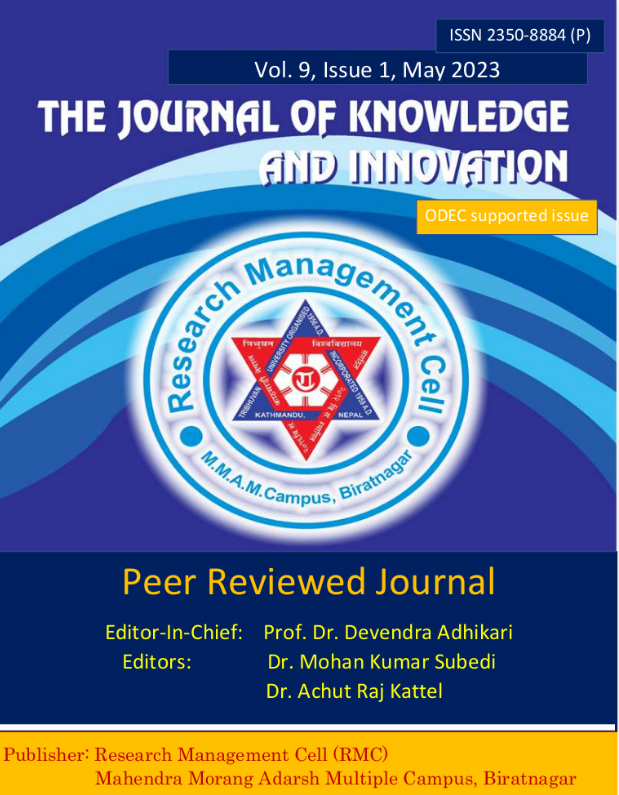शाहजहाँको इच्छा कवितामा संसक्ति व्यवस्था
DOI:
https://doi.org/10.3126/jki.v9i1.53508Keywords:
निदर्शन, सार्वनामीकरण, प्रतिस्थापन, लोप, संयोजन समाख्याताAbstract
प्रस्तुत लेख लक्ष्मीप्रसाद देवकोटाको शाहजहाँको इच्छा कवितामा संसक्ति तथा संसक्तिअन्तर्गतको व्याकरणिक संसक्तिको विश्लेषणमा केन्द्रित छ । नेपाली साहित्यमा बहुआयामिक व्यक्तित्व, नेपाली साहित्यको उन्नयन र विकासका लागि समग्र जीवन खर्चने लक्ष्मीप्रसाद देवकोटाको प्रस्तुत शाहजहाँको इच्छा सिर्जनागत प्रप्तिका दृष्टिले नेपाली कविता परम्पराको उच्चतम प्राप्ति हो । परिष्कृत, परिमार्जित र उच्च काव्यिक शिल्प प्रस्तुत भएको प्रस्तुत कविता देवकोटाको सुसम्बद्ध लेखनशैली अवलम्बन भएको संसक्तिपूर्ण भाषिक सङ्कथन हो । सङ्कथन वाक्यभन्दा माथिको सम्पूर्ण भाषिक संरचना हो भने सङ्कथन विश्लेषण संरचनाको भाषापरक अध्ययन गर्ने नवीन विश्लेषण पद्धति हो । सङ्कथन विश्लेषणका विभिन्न पद्धतिमध्ये संसक्ति व्यवस्था एउटा अधार हो । संसक्ति भन्नाले कुनै पनि पाठभित्र हुने अन्तर्सम्बन्ध तथा अनुच्छेदभित्रका वाक्यहरूमा भावप्रवाह सिर्जना गर्ने विशिष्ट ढाँचा हो जसले पाठभित्रका एकाइलाई सुसम्बद्धता प्रदान गर्दछ । संसक्ति व्यवस्थाअन्तर्गत व्याकरणिक संसक्तिले संंरचनामा रहेका व्याकरणिक प्रकार्यमा माध्यमबाट पाठलाई एकान्वितपूर्ण र सुसम्बद्ध तुल्याउन अहम् भूमिका खेल्दछ । प्रस्तुत कवितामा सन्दर्भन एकाइका रूपमा आएका व्याकरणिक संसक्तिले पाठमा रहेको सूचनालाई प्रवाहमय तुल्याई काव्यिक संरचनालाई कविको स्वच्छन्द भावप्रवाह गर्ने शैलीलाई सुसम्बद्ध तुल्याउन अहम् भूमिका खेलेको छ । कवितामा अन्यन्त न्यून निदर्शनको प्रयोग भए पनि तिनको भूमिका सुसम्बद्ध पाठ निर्माणका लागि सबल छ भने सार्वनामिक एकाइका रूपमा रहेका सन्दर्भनले पाठमा रहेका सन्दर्भ र अर्थलाई परस्परमा संसक्ति गरेका छन् । कवितामा प्रतिस्थापित एकाइ शब्द र वाक्यलाई परस्परमा जोड्ने एकाइका रूपमा नभई बृहत्तर आर्थीसम्बन्धसँग सन्दर्भलाई परस्परमा सम्पृक्त गराउने यस कृतिमा लोपले निरन्तर सूचनाप्रवाहलाई परस्परमा संसक्ति गर्न महत्त्वपूर्ण भूमिका खेलेका छन् । शब्द, पदावली, वाक्य र अनुच्छेदमा प्रवाह भएको सूचनालाई अनुच्छेदका तहमा निर्माण हुने सन्दर्भ र अर्थसँग जोड्ने महत्त्वपूर्ण भाषिक प्रकार्यका रूपमा संयोजनको स्थान रहेको निष्कर्ष निकालिएको छ ।
The presented article focuses on the analysis of Sansakti and grammatical Sansakti in Shah Jahan's Ichha poem by Lakshmi Prasad Devkota. A multifaceted personality in Nepali literature, Lakshmi Prasad Devkota, who spent his whole life for the promotion and development of Nepali literature, Shah Jahan's Will is the highest achievement of Nepali poetry tradition in terms of creative achievement. The presented poem with sophisticated, modified and high poetic craft is a coherent linguistic collection that adopts Devkota's coherent writing style. Sankthan is the entire linguistic structure above the sentence, while Sankthan analysis is a new analysis method for the linguistic study of the structure. Among the various methods of cluster analysis, the clustering system is one of the bases. Cohesion is a specific structure that creates a flow of meaning in the interrelationships within any text and the sentences within the paragraphs that provide coherence to the unit within the text. Grammatical structure under the syntactic system plays an important role in making the text coherent and coherent through the grammatical functions in the structure. In the presented poem, the grammatical structure that comes as a reference unit has played an important role in making the information in the text flow and making the poetic structure compatible with the poet's style of expressing his emotions. Even though there is very little use of reference in the poem, its role is strong for creating a coherent text, while the reference as a universal unit has linked the context and meaning in the text. Instead of uniting the words and sentences in the poem as a unit that connects the context with a larger meaning, the omission has played an important role in connecting the continuous flow of information in this work. It has been concluded that combination is an important linguistic function that connects the information flowing in words, vocabulary, sentences and paragraphs with the context and meaning created at the level of paragraphs.
Downloads
Downloads
Published
How to Cite
Issue
Section
License
Copyright (c) 2023 Research Management Cell (RMC), Mahendra Morang Adarsh Multiple Campus

This work is licensed under a Creative Commons Attribution-ShareAlike 4.0 International License.
This license allows reusers to distribute, remix, adapt, and build upon the material in any medium or format, so long as attribution is given to the creator. The license allows for commercial use.




